Wednesday March 20 started cloudy, but it cleared in the early afternoon and warmed up considerably. High of 23C. The air quality in Tassie (what the locals call Tasmania) is fabulous.
Our destination was the Museum of Old and New Art (MONA), which is located in Barriedale, a suburb in the northern part of Hobart about a 20 minute fast ferry ride away. David Walsh (b. 1961) is the owner of MOMA, and is a total character. He is from the Glenorchy district of Hobart and made his fortune by developing a gambling system used to bet on horse racing and other sports. In 2001, he founded the Moorilla Museum of Antiquities on the Berriedale peninsula in Hobart, which closed in 2007 to undergo a $75 million renovation. It re-opened in January 2011 as the MONA. MONA won the 2012 Australian Tourism Award for best new development and is a major Tasmanian tourist attraction. We had an amazing day at MONA.
I had taken a picture of the two MONA ferries the night before. We took the MR-1 at noon and arrived at around 12:20 p.m.
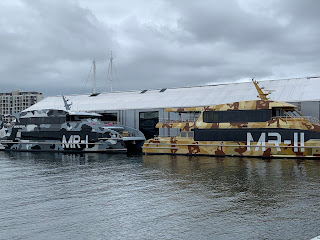 |
| We took the MR-1 |
 |
| At the helm |
 |
| Cow on the boat |
 |
| Gorgeous bridge en route |
 |
| Folks were sitting on the sheep |
 |
| Alain on the ferry |
 |
| Arriving at MONA- incredible building built into rock |
 |
| Disembarking the ferry |
 |
| Entrance to the museum |
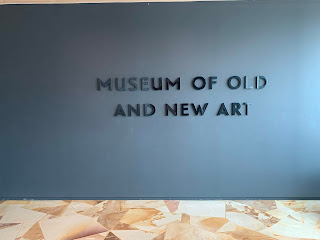 |
| Entrance |
We got a headset and smartphone with details about the art-- there were no labels. There were also written comments from David Walsh and info on the pieces as well as interviews with some of the artists- all on the smartphone. We were able to save what we saw and I received an email with the details after our visit. We took a elevator down to the B3 level and then made our way up to the ground level. There are also a number of bars, restaurants and a café in the museum.
 |
| Alicja Kwade- WeltenLinie 2018. Lives and works in Berlin. A larger version was in the Venice Biennale of 2017. |
We were very taken with the piece below called
bit.fall 2001-2006 by Julius Popp (b. 1973, Nuremberg) done with computer, pump, 320 magnetic valves, stainless steel basin and water. The computer makes the words that are commonly searched on the internet from water and lets them fall quickly through the air. The backdrop is the walls of the museum.
 |
| Very fast words in water |
 |
| Later taken from a higher level |
There was a temporary exhibit called
Your Shadow Rising, which featured a number of works from Toby Ziegler (b. 1972), a London artist. Very interesting pieces that can take months to construct.
 |
| The human engine 2018 |
 |
| Last Ray 2018 (oil on aluminium) |
 |
Your shadow rising 2018 - an amazing piece based on a clay figure that he saw in a museum in Beirut that had melted.
He worked in 3D and then did the piece in cast aluminium. |
There was another fabulous temporary exhibit
ZERO, which featured major artworks from the ZERO movement, shown together in Australia for the first time. Zero was founded in the late 1950s by three students in Düsseldorf - Heinz Mack, Otto Piene and Günther Uecker. They called themselves 'Zero'- a promise of new beginnings.
ZERO denotes their wider, longer-lasting international connections across Europe and beyond. They wanted to break free from the individualism of the artists after WWII and instead believed art should be assembled and constructed with others, using whatever materials came best to hand. The founding group disbanded in 1966. The exhibit contained rare surviving artworks from the group and their like-minded collaborators.
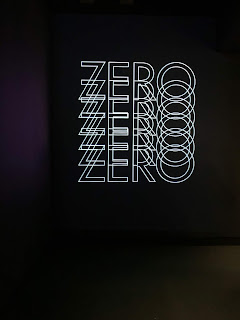 |
| Entrance to exhibit |
 |
| Spiegelenvironment (Mirror Environment) 1963; recreated in 2018 Christian Megert (b. 1936 Bern- works in Düsseldorf). He exhibited with the Zero artists in 1962. |
 |
| 3 Sphères-Trames (Grid Spheres) 1962, 1962, 1966 François Morellet, (1926-2016) |
 |
| Doble progresión azul y negra (Double Progression Blue and Black) 1975 Jesús Rafael Soto (1923-2005) born in Venezuela, moved to Paris in 1951. He showed with Yves Klein and the founders of Zero. |
 |
| Lichtregen (Light Rain) 1966; recreated 2018 Günther Uecker (b. 1930) . In 1966, he began using nails in artworks; applying self-prepared paint with his hands; he took inspiration from Vladimir Mayakovsky's inunction that "Poetry is made with a hammer." |
Günther Uecker met Yves Klein, Heinz Mack and Otto Piene in 1957 and exhibited with then and formally joined them as the third member of Zero in 1961. He later taught at the Düsseldorf Academy from 1974-95. In 2008, he co-founded the International ZERO foundation with Otto Piene, Heinz Mack and the City of Düsseldorf.
 |
| Structural Constellation 1959- Josef Albers (b. 1888 Germany, moved in 1933 to the US; died 1976, New Haven CT) |
 |
| Other pieces from artists in tune with the Zero group |
 |
| Mélangeur (Mixer) Pol Bury (b. 1922 Belgium, died 2005, Paris) |
 |
| Petite vibration brique et noire (Small Brick and Black Vibration)- Jesús Rafael Soto |
 |
| La spirale (The Spiral) 1958; editioned in 1969 Jesús Rafael Soto |
 |
| No. B.B.B. Yakoi Kusama (b. 1929, Matsumoto, Nagano, Japan) |
 |
| Concetto spaziale (Spacial Concept) 1965 Lucio Fontana (b. 1899, Argentina; moved in 1927 to Italy, died 1968) |
 |
| Pigment Pur (Pure Pigment) Original installation 1957; recreated in 2018 Yves Klein (1928-1962) |
 |
| Variable Lighting Scheme 1965 Grazia Varisco (b. 1937 Milan) |
 |
| Verschiedene Stelen (Various Steles) 1964-2013 Heinz Mack (b. 1931) |
 |
| Pirouetten (Pirouettes) 1960s; recreated in 2012, Otto Piene (1928-2014) |
ZERO was a fantastic exhibit. It also dove-tailed nicely with the kinetic art exhibit we had seen in at the
Kunsthal Rotterdam last October.
 |
| Void bar in the B3 (deep basement) level of the Museum |
 |
| Alain walking between the exhibits |
There were also a number of permanent pieces called
Monanisms- Highlights of David Walsh's Collection. In one room there was a piece called
Wind Section Instrumental (the most recent drawing) by Cameron Robbins. Pinned on the wall was the most recent artwork created by his wind-drawing machine,
Wind Section Instrumental. It was made over a two-week period. The machine is located outside and is powered by wind, which in turn moves the pen. When we were in the room, there was hardly any wind and the pen wasn't really moving.
 |
| Inside at the drawing table |
 |
| Finished work after two weeks |
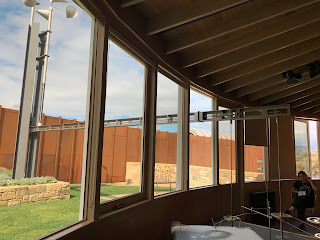 |
| Machine outside hooked up to pen inside the room |
We then saw a fabulous piece called
Hiroshima in Tasmania- The Archive for the Future, 2010 done by Masao Okabe and Chihiro Minato. Okabe was born in 1940 in Nemuro, Hokkaido, Japan who now lives and works in Sapporo, Japan and Minato was born in 1960 in Fujisawa, who now lives and works in Tokyo. The piece is based on a work shown at the Japanese Pavilion at the 52nd Venice Biennale. The work is comprised of stone remains from the Ujina railway station platform in Hiroshima. The station was built in 1894 and used as a military station until it was destroyed by the atomic bomb. The remains were removed in 2002. Masao Okabe worked at the site for 9 years to make more than 4000 frottages (rubbings) from the stones. Plants and drawings made with the soil are also on display. Minato, an artist and teacher, was the Japanese Commissioner for the Venice Biennale of 2007.
 |
| MONA also got the stones from the railway station |
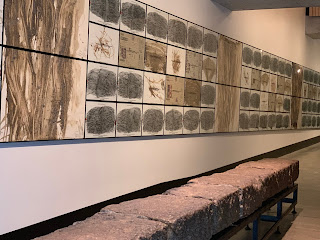 |
| An amazing project - traces of the past |
There was an amazing piece by Anselm Keifer called
The Breaking of the Vessels, 2007. It was a bookcase comprising two iron elements with lead books (190-200 volumes) and glass.
 |
| Anselm Keifer (b. Germany 1945) -- lots of references to book burning, Kristallnacht. The title of the piece on the wall Shevirath ha Kelim 'the Breaking of the Vessels' comes from the Kabbalah. |
There was also a reconstruction of Vermeer's 17th-century studio. Tim Jenison, a computer graphics professional is going to be spending the next few months making a painting of this room, with his comparator process using a mirror-based system similar to the one he used in the film
Tim's Vermeer to paint
The Music Lesson.
 |
Tim Jenison and Vermeer
There was also an interactive part of the exhibit where one looked through a mirror and sketched a Vermeer painting. I tried my hand at The Girl with a Pearl Earring (one of my favourites).
|
 |
| Me sketching |
 |
| My attempt---lots of fun |
Fat Car was an amazing piece by Erwin Wurm done in 2006. The artists story is that cars are getting bigger as people are getting bigger and they want bigger cars to cram all their stuff into (consumption gone amok) and want their cars to be bigger than other people's cars.
 |
| Fat Car - Erwin Wurm (b. Bruck an der Mur, Austria, lives and works in Vienna) |
In one room was a piece called
Snake, done by Sidney Nolan 1970-72. It was mixed media on paper with 1620 sheets- a vast mural more than 46 metres long and 9 metres high. It is the artist's largest work.
Snake was partly inspired by the Australian desert in bloom after rain and also by Nolan's fascination with ancient indigenous cultures.
 |
| Snake- Sidney Nolan (b. 1917 Melbourne, died 1992, London) |
 |
| Detail from Snake |
WOW! The museum more than exceeds the hype. We arrived just before 12:30 p.m., stopped for a lovely lunch outside, then back into the museum, which we left at around 5:00 p.m. We then had time for one of David Walsh's Moo Brews from his brewery served at the lovely Wine Bar. We caught the last ferry at 6:00 p.m. back to Hobart.
 |
| View of Mount Wellington from MONA |
 |
| The Wine Bar |
 |
| More outdoor art--- also a stage area for concerts |
 |
| Another gorgeous view |
 |
| With my dark ale-- there was blue sky and it was about 23C late in the afternoon |
 |
| Ferry coming in |
 |
| Docking at around 5:50 p.m. |
 |
The view heading back to Hobart
While there were some pieces that weren't our cup of tea, the vast majority of the permanent collection along with the terrific temporary exhibits were provocative and innovative and the write-ups and interviews were very well put together. There were also irreverent, "Gonzo", as he called them, written comments on the art by David Walsh, MONA's owner. It really was a fantastic day!
|





















































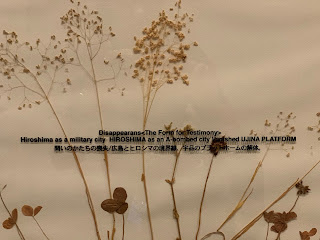





Comments
Post a Comment